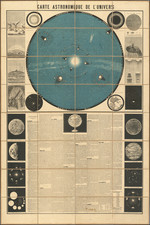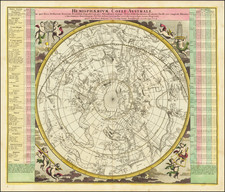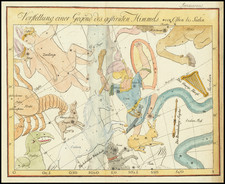A rare star chart centered on Taurus, with an important historical dedication.
This copy was dedicated "To the Reverend Philip Doodridge D.D. President of the Philosophical Society at Northampton," an 18th century scientific society based in Northampton, which met at the home of Thomas Yeoman. It bears the motto dum vivimus vivamus (While we live, let us live). Northampton was also home to Bevis' printer / publisher, John Neale. The earliest known advertisement for the publication of John Bevis' Uranographia Britannica appeared in the Northampton Mercury on April 11, 1748, and it is likely that this society played a significant role in the attempt to finance and publish Bevis' work,
The Uranographia
Historians of astronomy name four great celestial atlases: Bayer's, Hevelius's, Flamsteed's, and Bode's. To this, they add one great work that could have been: Bevis's Uranographia. While the creation of this work achieved much notoriety and the publication was greatly awaited, the printer Neale's bankruptcy derailed the project. Fortunately, the plates had already been made and separately issued copies, in addition to thirty completed works, were made.
The atlas comprised 51 plates, the same number as Bayer's. Further, each plate analyzes the same celestial region. However, Bevis greatly added to the detail of Bayer's work, drawing on his own astronomical knowledge. Copies of these printings which survived were of great public and scientific interest at the time.
Careful cross-referencing of the dedications on each work allows the date for the creation of the plates to be constrained to between 1747-1749. By comparing the titles suggested in the work to Royal Society and clergy records, upper and lower bounds of the date of creation can be made.
References to a posthumous 1786 Bevis Atlas Celeste prove difficult to follow. Academic debate as to the nature of a paper residing in the British Library copy of the Uranographia advertising a 1786 publication suggests that there was an effort after Bevis's death to resell the work, without crediting him. Other "title page" editions, including one from 1818 held at Cambridge's Whipple Library, advertise a similar thing. Ashworth concludes that several later entrepreneurs tried to resell the original copy under their own name, with the 1786 copy being a prime example of a "ghost work."
Publication History Revisited
The following is excerpted from "Naturae Accedere Partes: The Northampton Philosophical Society Revisited" , by David Bates Northamptonshire Past and Present, No 53 (2000).
Bates notes:
The genesis of Bevis’s Uranographia Britannica will probably always remain something of a mystery. The origin of the partnership between the two principals [Bevis and Neale] is not known; certainly they would have moved in the same circle of instrument makers, lecturers and philosophers and, in 1747, Neale’s Directions for Gentlemen included an appendix of six electrical experiments communicated by Bevis. However, a new celestial atlas was an entirely different undertaking and John Neale’s motive for embarking on such an ambitious enterprise, with very little previous experience of publishing, is not apparent.
Equally, Bevis’s reasons for entrusting his work to such a relative novice are unfathomable. Prof. [W.B.] Ashworth has speculated, on the basis of the omission of Bevis’s name from the proposals and the preponderance of London instrument makers among the agents and subscribers, that Neale may have been acting as the leader of a consortium. In any event, the exact chronology and details of the failure are far from clear.
What cannot be doubted is the vast expense of producing a large volume of finely engraved maps; the proposals were emphatic on this point: ‘the Undertaker has spar’d no Expense to get the Plates as elegantly executed as possible … the Whole shall be printed on a fine white Demy Writing Paper, made on purpose for this Work’. Despite the advanced state of the publication – all the plates were prepared – and the list of expectant subscribers, the venture collapsed in 1750. The assets, in the form of the engraved plates, were sequestered by the Court of Chancery and Neale was declared bankrupt.
Although it was never properly published, fortunately for historians of astronomy and for Bevis’s posthumous reputation, the work has survived intact as a number of complete copies of proof plates. As an abortive publication, Uranographia Britannica has always been something of a bibliographical anomaly, a ‘ghost book,’ and for many years it remained neglected or misinterpreted. It was not until Prof. Ashworth’s definitive study that its full significance was finally appreciated.
In the form that survives, Bevis’s great work is a magnificent example of the celestial cartographer’s art. As promised in the proposals, it comprised 51 plates: 48 charts of the Ptolemaic constellations, one of the constellations of the southern hemisphere and two planispheres of the Ptolemaic constellations. The printed area of each chart, including the dedication, measures 375 x 312 mm, and each constellation is accompanied by an explanatory table; the tables have survived in fewer copies than the plates. Prof. Ashworth has concluded that the atlas is based on the 1725 catalogue of John Flamsteed, augmented by Bevis’s own observations, a total of 3,551 stars in the catalogue, reduced to the epoch 1746.
The individual plates are finely executed, the design and layout closely following the precedent of Bayer’s Uranometria of 1603. Had it been published, Uranographia Britannica would have been the natural successor to Flamsteed’s own Atlas Coelestis (1729). All of the plates carry dedications and two of them are dedicated to the Northampton Philosophical Society. Plate XXII, Aries, is dedicated to the society itself (Figure 1) and the adjacent Plate XXIII, Taurus, to its president, Philip Doddridge (Figure 2).
In general, there appears to be no rationale for the association of the 51 plates of Uranographia with their respective dedications; there is, however, one example of an obvious if whimsical connection between subject and dedicatee. The constellation Triangulum (plate XXI) is represented by a geometer’s drawing instrument, a triangle, and the dedicatee is Nathaniel Bliss, Savilian Professor of Geometry at Oxford; perhaps more subtle allusions are also to be found in the atlas. If the dedication of the plates was largely a matter of chance, it was certainly a fortuitous coincidence that Doddridge’s Taurus plate should be one of the most important plates in the entire atlas in terms of its astronomical significance. Not only is the Taurus plate one of the boldest and most attractive compositions but, more importantly, it depicts one or possibly two newly-discovered objects. Towards the tip of the bull’s right (southern) horn is the famous Crab Nebula, a supernova remnant, first observed by Bevis and credited to him as the first in Charles Messier’s 1781 catalogue of nebulous objects, M1. The second is a faint object, no longer visible in the position indicated, that has recently been proposed as an early ‘prediscovery’ observation by John Flamsteed of the planet Uranus.
Remarkably, Bevis possibly made his own independent prediscovery observation of Uranus in 1738; it is depicted on the Sagittarius plate of Uranographia. If this conjecture is correct, it would be yet a further irony of Bevis’s career that the honour of discovering the first new planet of the modern era eluded him; it was not until 1781 that William Herschel eventually recognized and named the newly-discovered planet.
. . . Following the shambles of Uranographia Britannica, Bevis was deeply troubled by the disenchantment of some of his subscribers and their insinuations of incompetence or even malpractice. He nevertheless resumed his astronomical work and continued to publish his observations; these included the lunar eclipse of December 1750, transits of Mercury and Venus and the return of Halley’s comet in May 1759. He endured further personal disappointment when he failed to secure the post of Astronomer Royal on the death of Nathaniel Bliss in 1764. Although his work for Uranographia Britannica had brought him recognition from overseas (he was elected a member of the Berlin Academy of Sciences in 1750), honour came belatedly in his own country when he was eventually elected to a fellowship of the Royal Society in 1765. He died on 6th November 1771, reputedly as the result of a fall from his telescope. Long after the demise of its creator, Uranographia Britannica has recently enjoyed something of a revival in fortunes and Bevis’s standing has risen accordingly. Following the work of Mrs. [Helen] Wallis, Prof. Ashworth and others, the atlas has rightly been instated among the great works of celestial cartconstruction of scientific instruments in ography. Approximately 16 copies, in various states of completeness, are now known; five copies originally in the collection of the astronomer John Couch Adams are at the University of Cambridge, and another complete copy was recently discovered to great acclaim in the library of the Manchester Astronomical Society.
John Bevis (1695-1771) was an Oxford-trained physician and amateur astronomer, who is perhaps best known for his discovery of the Crab Nebula in 1731, 27 years before Charles Messier's re-discovery. Bevis set up a private observatory in North London in 1738, where he made observations, which led to his attempt to create the second British Celestial Atlas. In the mid 18th Century, Bevis produced his Uranographia Britannica, which was the first major celestial atlas published after the posthumous publication of the Atlas of John Flamsteed, England's first Royal Astronomer.
Although many astronomers praised the Flamsteed atlas for its accuracy, others were unhappy with the unwieldy size and inelegant plates. This dissatisfaction resulted in John Bevis's decision to base his work on Bayer's Uranometria, rather than Flamsteed. Bevis succeeded in having the plates engraved for his atlas with the assistance of publisher John Neale, but Neale's bankruptcy prevented publication of the Atlas, although a star catalog was printed.
The bankruptcy of Neale resulted in the plates being sequestered by the courts, and the Bevis Uranographia, as it was to have been called, was not published until 1786, some 15 years after his death, and then only as part of composite atlases. Fortunately, a number of impressions were printed from the plates before they disappeared, and nearly all of these sixteen pre-publication sets are still preserved in various libraries around the world.
When one compares the Bevis atlas to Bayer's Uranometria, it is apparent that Bevis followed the plan of the Bayer atlas exactly. There are the same number of plates, of the same size, and each covers the same area of the sky. The constellation figures are also stylistically identical. But the two are not the same. Bevis has more stars, and more accurate positions for those stars. He also took pains to include the many new or variable stars that had been recently discovered, as well as the nebulous objects. There are in fact nine Messier objects on the Bevis charts (including M1, which Bevis discovered), and five of them had never before appeared in a star atlas.









![[Constellations, No. 9]](https://storage.googleapis.com/raremaps/img/small/81822.jpg)


![[ Cygnus ]](https://storage.googleapis.com/raremaps/img/small/83197.jpg)
![[Ion Powered Spacecraft Traveling To Mars]](https://storage.googleapis.com/raremaps/img/small/83629.jpg)
